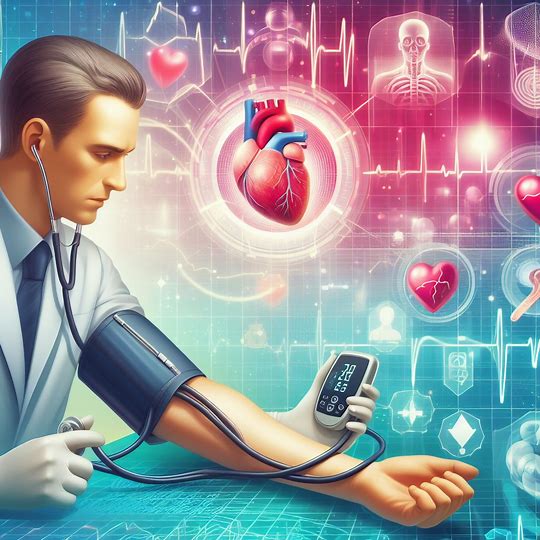Discover the essentials of managing low blood pressure efficiently with expert insights and practical advice.
Table of Contents
Introduction – Low Blood Pressure
Low blood pressure, also known as hypotension, is a condition where the force at which blood is pumped through the blood vessels is lower than normal. Blood pressure readings consist of two numbers: systolic and diastolic. Hypotension occurs when one or both of these numbers are below the established threshold, often leading to inadequate blood flow to the organs of the body. While some individuals with low blood pressure may not experience any symptoms, others may encounter issues affecting their daily lives. Understanding the normal ranges of blood pressure and recognizing the signs of hypotension is crucial for maintaining overall health.

The causes of low blood pressure can be as benign as dehydration or as serious as medical conditions that warrant prompt attention. Various factors contribute to the development of hypotension, including but not limited to certain medications, heart problems, endocrine disorders, and severe infections. Identifying these causes is integral to the proper diagnosis and management of low blood pressure. Treatment may involve medications, lifestyle and dietary changes, or addressing the underlying health issues that are causing the blood pressure to drop.
Key Takeaways
- Low blood pressure is a condition marked by blood pressure readings that are lower than normal. It can potentially lead to inadequate organ perfusion.
- Identifying the underlying causes of hypotension is essential for effective treatment and prevention.
- Proper management of low blood pressure often requires a comprehensive approach, including lifestyle modifications and, in some cases, medical intervention.
Understanding Blood Pressure

Blood pressure is a critical measurement related to the health of the body’s circulatory system, particularly the force exerted by circulating blood on the walls of blood vessels.
What Is Low Blood Pressure?
Low blood pressure, or hypotension, occurs when blood pressure is much lower than normal, which means that the heart, brain, and other parts of the body might not receive enough blood. Symptoms can include dizziness or lightheadedness. When blood pressure reading is lower than 90 millimeters of mercury (mm Hg) for the top number (systolic) or 60 mm Hg for the bottom number (diastolic), it is considered low blood pressure.
Systolic and Diastolic Explained
Systolic pressure is the pressure in the arteries when the heart beats and fills them with blood. Diastolic pressure is the pressure in the arteries when the heart rests between beats. Arteries must be flexible to accommodate these changes in pressure. Consistent readings of 120/80 mm Hg are typically considered normal for systolic and diastolic pressures.
| Key Findings | URL |
|---|---|
| Causes and symptoms of low blood pressure | Mayo Clinic |
| Treatment options for hypotension | WebMD |
| Understanding blood pressure numbers | Cleveland Clinic |
| How pregnancy affects blood pressure | American Heart Association |
| Overview of low blood pressure (hypotension) | Cleveland Clinic |
Causes and Risk Factors

Low blood pressure, medically known as hypotension, can stem from various causes and is influenced by several risk factors. A clear understanding of these can help identify and manage this condition effectively.
Common Causes of Hypotension
Certain conditions and lifestyle choices can cause low blood pressure. Dehydration occurs when the body loses more water than it takes in, leading to a drop in blood volume and consequently, blood pressure. Heart conditions, such as extremely low heart rate, heart valve problems, and heart failure, can prevent the heart from circulating enough blood. Some medical issues involving the autonomic nervous system, which regulates involuntary functions, may also result in hypotension. For instance, conditions like Parkinson’s disease disrupt the body’s blood pressure control mechanisms.
- Dehydration: Can result from inadequate water intake, vigorous exercise, or illness leading to vomiting and diarrhea.
- Heart Conditions: Can cause low blood pressure due to impaired heart function or failure.
- Autonomic Nervous System Disorders: Conditions like Parkinson’s disease can interfere with blood pressure regulation.
Risk Factors for Developing Low Blood Pressure
Risk factors for hypotension are conditions or scenarios that increase the likelihood of developing low blood pressure. Aging is a risk factor because the body’s ability to balance blood pressure can decrease with time. Pregnancy can cause fluctuating blood pressure levels due to the circulatory system’s adjustments. Health conditions such as diabetes can affect the autonomic nervous system and blood pressure. Furthermore, excessive alcohol consumption can lead to short-term hypotension episodes.
- Aging: Older individuals may experience blood pressure drops more frequently.
- Pregnancy: Blood volume increases during pregnancy, which can result in lower blood pressure.
- Diabetes: Can damage the autonomic nervous system over time, affecting blood pressure control.
- Alcohol Consumption: Excessive drinking can lead to temporary drops in blood pressure.
| Key Findings | Relevant Links |
|---|---|
| Dehydration as a cause of hypotension | Mayo Clinic |
| Heart conditions leading to low blood flow | Cleveland Clinic |
| Autonomic nervous system and hypotension | Verywell Health |
| Age-related changes in blood pressure | WebMD |
| Effects of alcohol on blood pressure levels | Medical News Today |
Symptoms and Diagnosis

Identifying and properly diagnosing low blood pressure is crucial for managing the condition and preventing complications. It is important to recognize the symptoms and understand the diagnostic process.
Recognizing the Symptoms
Low blood pressure can manifest through a variety of symptoms. Some individuals may experience dizziness, feeling lightheaded, or even fainting. Fatigue is another common symptom, together with nausea. These symptoms can lead to an increased risk of falls. In more severe cases, patients might report confusion, which necessitates prompt medical attention.
How Is Low Blood Pressure Diagnosed?
Healthcare providers typically conduct a blood pressure test during a physical exam to diagnose low blood pressure. If a person’s blood pressure reading is below 90/60 mm Hg, they may be diagnosed with hypotension. Additional blood tests might be ordered to determine the underlying cause of the low blood pressure.
| Key Symptoms | Diagnostic Methods |
|---|---|
| Dizziness | Blood pressure test |
| Fainting | Blood tests |
| Lightheadedness | |
| Confusion | |
| Nausea | |
| Fatigue |
For more information on the symptoms and causes of low blood pressure, refer to the Mayo Clinic and for a comprehensive guide on treatment options, visit WebMD. Additional details on diagnosis can be found at Cleveland Clinic.
Treatment and Management

Effective management of low blood pressure requires a multifaceted approach that includes various treatments and lifestyle adjustments. The specific methods depend on the underlying causes of hypotension and the individual patient’s needs.
Approaches to Treating Hypotension
When treatment is necessary for low blood pressure, it might include medications such as fludrocortisone, which helps to increase blood volume, or midodrine, which elevates blood pressure by restricting blood vessels. Compression stockings are also effective in mitigating symptoms related to orthostatic hypotension by aiding venous return and reducing blood pooling in the legs.
Lifestyle Changes and Home Remedies
In many cases, simple lifestyle changes can help manage symptoms of low blood pressure. Increasing the intake of salt and water can significantly boost blood pressure; however, this must be done under medical guidance to avoid excesses that can harm overall health. Establishing a diet that supports healthy blood pressure and using home remedies like increasing fluid intake are generally recommended starting points.
| Approaches | Description & Keywords | Relevant Sources |
|---|---|---|
| Medication | Fludrocortisone and midodrine are common drugs for hypotension. | Mayo Clinic |
| Compression Stockings | Help improve blood flow, often used for orthostatic hypotension. | Cleveland Clinic |
| Diet and Hydration | Increase in salt and water can be beneficial per physician’s advice. | Cleveland Clinic Health Essentials |
| Physical Counterpressure | Maneuvers like crossing legs, clenching muscles to avert drops in blood pressure. | Verywell Health |
Using this resource-laden and structured approach, they can effectively manage low blood pressure and mitigate the associated risks and discomforts.
Complications and Considerations

Understanding the potential complications and specific considerations of low blood pressure is crucial for comprehensively managing the condition and preventing serious outcomes. This section will detail the recognized risks associated with hypotension and highlight the special considerations that need to be made for different populations affected by this condition.
Potential Complications of Hypotension
Low blood pressure, or hypotension, can lead to several complications, particularly when it drops significantly and deprives the body of essential oxygen and nutrients. Shock is one severe consequence, which is a life-threatening condition that occurs when blood pressure is so low that the body’s organs do not receive enough blood flow. Specific types can include anaphylactic shock, caused by a severe allergic reaction, and septic shock, stemming from a serious infection. Persistent low blood pressure can also lead to long-term effects such as heart or brain damage due to insufficient oxygen supply.
Another concern is orthostatic hypotension, also known as postural hypotension, a form of low blood pressure that occurs when standing up from sitting or lying down. It can lead to dizziness and fainting, increasing the risk of injury from falls. Similarly, neurally mediated hypotension can cause syncope (fainting) in response to triggers like prolonged standing or emotional distress.
Here is a table summarizing some key complications:
| Complication | Description | Consequences |
|---|---|---|
| Shock | Severely low blood pressure leads to inadequate blood flow | Organ failure, life-threatening |
| Anaphylaxis | Allergic reaction resulting in drastic blood pressure drop | Respiratory distress, shock |
| Septic Shock | Severe infection leading to extreme low blood pressure | Multiple organ dysfunction |
| Orthostatic Hypotension | Sudden blood pressure drop when standing | Falls, fainting, injury |
Special Considerations in Different Populations
Certain groups are more susceptible to the complications of low blood pressure and may require tailored management approaches. For instance, the elderly may have a higher risk of falls due to orthostatic hypotension. Pregnant women often experience a natural drop in blood pressure during pregnancy, particularly during the first 24 weeks, which necessitates monitoring to avoid potential harm to the mother and fetus.
Additionally, individuals with specific health conditions such as Parkinson’s disease and diabetes may have increased risk of developing low blood pressure, with distinct management plans required for these patients.
Here’s a table pinpointing special population considerations:
| Population | Condition | Consideration |
|---|---|---|
| Elderly | Orthostatic Hypotension | Increased risk of falls and related injuries |
| Pregnant Women | Naturally Lower Blood Pressure | Monitoring during first 24 weeks imperative |
| Patients with Parkinson’s Disease | Condition-related hypotension | Individualized management plans |
| Patients with Diabetes | Risk of blood loss from injuries | Enhanced preventative measures |
For more detailed information on the complications of low blood pressure, interested readers may refer to the resources from the Cleveland Clinic and the American Heart Association.
Frequently Asked Questions
This section addresses common inquiries about low blood pressure (hypotension), providing answers grounded in current understanding and practice.
What warning signs indicate a potentially emergency situation with low blood pressure?
Severe symptoms such as dizziness, fainting, or a rapid, shallow breathing pattern may precede an emergency situation related to low blood pressure. It is crucial to seek medical attention if blood pressure drops suddenly or is accompanied by symptoms like a cold, clammy skin or a weakened and rapid pulse, as detailed by the Cleveland Clinic.
How can one manage low blood pressure effectively at home?
To manage low blood pressure at home, it’s recommended to stay hydrated, eat small, frequent meals, and avoid alcohol. For some, increasing salt intake and wearing compression stockings can help. Techniques to gradually stand up can prevent sudden drops in blood pressure. The Mayo Clinic provides strategies for managing hypotension.
What symptoms typically present in females with hypotension?
Females may experience symptoms such as fatigue, lightheadedness, or bouts of fainting specifically related to changes in hormone levels. Menstruation, pregnancy, and menopause potentially exacerbate these symptoms. Information from WebMD highlights these correlations.
How does age affect the normal range of blood pressure readings?
As individuals age, blood vessels can lose some of their natural elasticity, potentially causing blood pressure to fluctuate or slightly increase. However, low blood pressure remains defined as readings lower than 90/60 mm Hg regardless of age. Verywell Health elaborates on how age correlates with blood pressure trends.
What should be done immediately if someone is experiencing hypotensive episodes?
Immediate responses to a hypotensive episode include laying the person down and elevating their legs to improve blood flow to the heart. If symptoms persist or worsen, it’s imperative to contact emergency services. Quick actions are essential, as reinforced by information on Mayo Clinic.
At what point does the diastolic reading signify a serious risk for health?
A diastolic reading below 60 mm Hg often warrants concern, as it may indicate inadequate blood flow to the organs. If this low diastolic pressure is consistent, it could signify a serious risk and necessitate medical evaluation, which is suggested by Cleveland Clinic experts.




